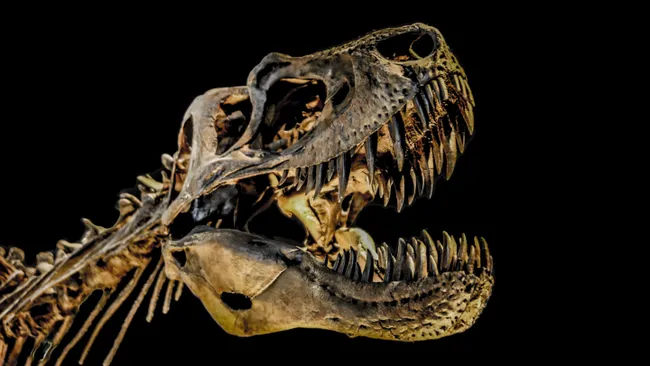A Tyrannosaurus rex researcher has found that there are now more scientifically valuable T. rex specimens in private or commercial ownership than in public museums, hampering research.
The Fossil Dilemma: How Private Collectors Are Impacting T. rex Research
In recent years, Tyrannosaurus rex fossils — some of the most iconic and scientifically important dinosaur remains — have become hot commodities in the world of high-end auctions and private collections. But while these fossilized giants make dramatic and valuable showpieces for the wealthy, scientists are raising concerns that the surge in private ownership is seriously affecting our ability to study and understand this legendary predator.
A new study led by Thomas Carr, a renowned paleontologist and associate professor of biology at Carthage College, has found that there are now more scientifically valuable T. rex fossils in private or commercial hands than in public institutions such as museums and universities. According to Carr, this trend could be undermining decades of research and leaving significant gaps in our understanding of the species’ biology, especially its early life stages.
Why T. rex Matters So Much
Tyrannosaurus rex is one of the most extensively studied dinosaur species in the world. Its massive skull, powerful bite, and formidable stance have fascinated paleontologists and the public alike. But while much is known about the adult T. rex, scientists are still trying to piece together how this apex predator developed from a juvenile into the 40-foot-long giant we recognize today.
To study this developmental journey, researchers rely heavily on access to juvenile and subadult fossils — specimens that are considerably rarer and often harder to identify. That’s where the problem begins.
“These early growth stages of T. rex are already poorly represented in the fossil record,” said Carr in an interview with Live Science. “So when those rare fossils end up in private hands and become inaccessible, it comes with a huge scientific cost.”
The Numbers Tell a Stark Story
In his study, titled “Tyrannosaurus rex: An endangered species,” published April 10 in Palaeontologia Electronica, Carr examined museum catalogs, auction records, news reports, scientific literature, and anecdotal evidence to tally up the number of T. rex fossils held in public versus private ownership.
He found:
- 61 scientifically informative T. rex specimens are currently housed in public collections.
- 71 comparable specimens — including 14 juveniles — are in private ownership.
- Commercial companies are now discovering twice as many specimens as public institutions.
- Only 11% of commercially harvested fossils end up in public trusts like museums.
Carr admits the numbers are likely an underestimate, citing the “secretive nature” of private fossil sales and the fact that new specimens are discovered nearly every year.
Fossils for Sale: A Growing Market
The fossil trade has exploded in recent decades. Dinosaur fossils, especially T. rex, fetch astronomical prices at auctions. In 2020, a near-complete T. rex skeleton named “Stan” sold for $31.8 million. Even more dramatically, in 2024, a Stegosaurus fossil was sold for an eye-watering $44.6 million, becoming the most expensive dinosaur fossil ever sold. That specimen was eventually loaned to the American Museum of Natural History — a rare case where a private sale benefited a public institution.
But this is not the norm. Most privately sold fossils are placed in homes or vaults where scientists cannot access them. As a result, researchers lose out on opportunities to study bone structures, conduct 3D scans, perform isotope analyses, or test theories about dinosaur behavior and evolution.
What Scientists Are Saying
Carr’s study is sparking conversation in the paleontological community.
Thomas Holtz, Jr., a vertebrate paleontologist at the University of Maryland, echoed Carr’s concerns. “It’s disheartening,” he said. “There are good specimens, especially juveniles and subadults, that could significantly clarify our understanding of T. rex development — and they’re locked away from scientific access.”
David Hone, a reader in zoology at Queen Mary University of London, offered a more measured view. While acknowledging the value of public access, he emphasized that illegal fossil trafficking poses an even greater threat. “I’d certainly love to see more specimens in public collections,” Hone said, “but there are rarer and more important things being traded illegally that concern me more — like fossils smuggled from Brazil or Mongolia.”
Still, Carr insists that ignoring the issue isn’t an option. He hopes his study will serve as a call to action for other paleontologists to “start counting up, and publishing on, the specimens of the species that they study that are lost to the commercial market.”
What Can Be Done?
The commercialization of fossils, especially in countries like the United States where fossil ownership laws are lenient on private land, is legal — but controversial. In contrast, countries like Mongolia and China have strict fossil export bans, which have also led to a black market in smuggled fossils.
Some paleontologists argue for stricter legislation to keep scientifically important fossils in public trust. Others advocate for incentives to encourage private collectors to donate or loan their specimens to museums.
Carr, meanwhile, urges the scientific community to keep speaking out. “Fossils are more than collectibles,” he said. “They’re data — vital records of ancient life that can unlock the secrets of evolution, extinction, and the history of our planet. When they disappear into private hands, that knowledge is lost.”
